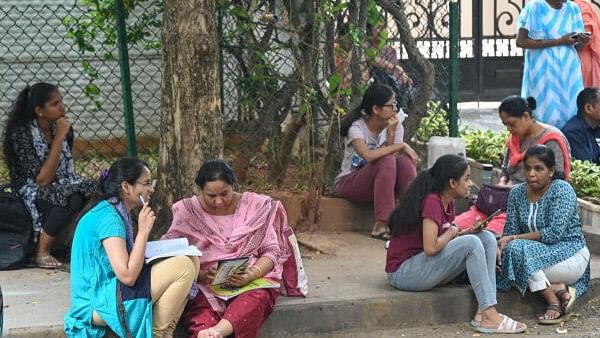
Students preparing before enter in to centre for written The Karnataka Common Entrance Test (KCET) for admission to first year Engineering, Technology, Naturopathy and Yoga, Agriculture (Farm science) Courses, B.Pharm, Veterinary and others courses, conducted by Karnataka Examinations Authority (KEA), at JSS Institute of Education, Jayanagar in Bengaluru.
Credit: DH Photo/ S K Dinesh
The increase in the number of those qualifying for engineering seats every year in the state has raised concerns over the quality of technology education and the graduates who come out of technical institutions.
The total number of engineering eligible candidates has been increased almost by a lakh in two years.
The number of students eligible to get admissions to engineering courses, after writing the Karnataka Common Entrance Test (KCET) this year is 2.74 lakh. It was 2.3 lakh in 2023 and 1.71 lakh in 2022.
According to experts, increasing number of students clearing II PU exams in science stream every year is the main reason for the rise in the number of those qualifying.
Karisiddappa, former vice chancellor of Visvesvaraya Technological University (VTU), said, “Basically, the number of students passing II PU exams in science stream is high and this is leading to more students opting for technical education.”
However, every year, Karnataka is witnessing many engineering seats remaining unfilled, despite the fact that the number of those qualifying for engineering courses is four times higher than the seats available.
Experts attribute this to poor infrastructure and the quality of education at some of the engineering institutions.
In 2023, the number of seats that remained unfilled was 18,229. As per data from the Karnataka Examination Authority (KEA), the number of seats available during 2023 was 1,00,351, of which 68,793 were government seats.
Govt quota
Under government quota itself, 10,691 seats were left unfilled last year. The number was 14,354 under ComedK. Experts say colleges must create better infrastructure to cater to the increasing demand for seats.
Vidyashankar S, VTU vice chancellor, said, “If students get good mentors and put in the best efforts in the engineering course, they can achieve big. Just getting an engineering degree is not enough nowadays, skill is very important. Colleges must consider hiring the best teachers and provide good infrastructure.”
To address concerns over the number of qualifying students being much higher than the number of seats available, Vidyashankar suggested that the government must consider increasing the government quota seats.
“We have increased seats for undergraduate courses at our constituent college in the Belagavi campus to 1,600. Not everyone will get admission under management or private quota,” he said.
Lack of skills
“The number of engineering graduates going jobless is increasing and it is mainly because of lack of skills. Placements will happen only if students have skills,” said the placement director at a private engineering college in Bengaluru.
For the 2024-25 academic year, VTU received only three applications to start new colleges. Also, not many colleges opted for seat enhancement, even though the All India Council for Technical Education (AICTE) removed the cap on intake for engineering courses.
There are over 303 private engineering colleges in the state affiliated to VTU, besides private and deemed-to-be universities which offer engineering education.
KCET easier
Experts point out that KCET being easy compared to other engineering entrance examinations may be one of the reasons for more students getting eligibility for engineering courses.
H N Ramesh, former principal of UVCE, said, “It is good that the number of candidates aspiring for engineering education is high. But colleges should maintain standard infrastructure, recruit quality teachers and train students in communication skills. Grooming students getting into tech education is very important to help them survive in the job market.”
Cut-off idea
In 2021, the then higher education minister Dr C N Ashwath Narayan mooted the idea to fix cut-off marks in KCET for all streams, mainly engineering.
The idea was to consider only KCET marks to award ranks for professional courses and also to fix a cut-off by working out a minimum eligibility marks for aspirants of seats in professional courses. However, the idea was not executed.